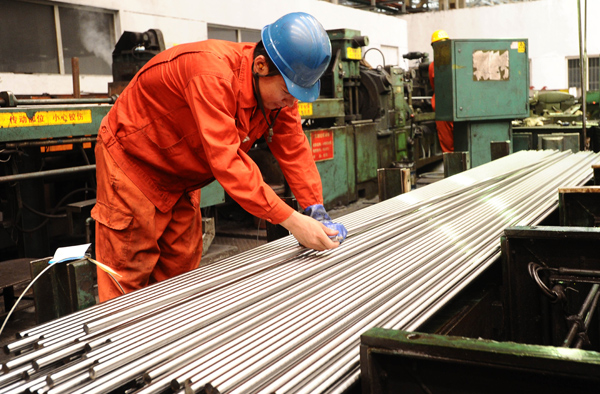China makes headway in steel capacity cut, challenges remain
(Xinhua) Updated: 2016-08-11 09:53
 |
|
A worker at a steel factory in Dalian, Northeast China's Liaoning province, August 10, 2016. [Photo/VCG] |
BEIJING - Efforts to reduce China's steel production overcapacity are forging ahead according to plan, the top economic planner said Wednesday.
In a medium-term roundup of the drive, the National Development and Reform Commission (NDRC) said, in an online statement, that the central government has rolled out general guidelines and NDRC has also strengthened guidance of local governments and major steel producers in drawing their own capacity cut plans.
The State Council guidelines, issued on February 4, dictated that steel production capacity must be reduced by 100 million tons to 150 million tons over the next five years, with some 45 million tons cut in 2016.
Xia Nong, head of NDRC industry department, said that the resolute measures have proven effective, the "People's Daily" reported Wednesday.
The drive will pick up speed in the second half of this year to achieve the goal, he said.
Inspection teams will be dispatched to local governments to oversee their work starting from mid-August, the report said.
Crude steel output posted a year-on-year decline of 1.1 percent in the first half of 2016, and operational conditions of the steel sector reported improvement.
In fact, China's crude steel production capacity utilization rate, 71.2 percent in 2015, was higher than the global average of 69.7 percent, data from the World Steel Association showed.
In the first half of 2016, China reduced steel capacity by 13 million tons, about 30 percent of the planned cuts for the whole year, a figure in line with expectations, according to Feng Fei, vice-minister of industry and information technology.
The campaign apparently gathered momentum in July, when another 17 percent of the target was finished.
In H1, work focused on breaking down tasks, so that they could be allocated to provincial-level regions, and the formulation of supportive measures for steel capacity cuts, Feng said.
In the second half, capacity cuts and supportive measures will gain speed, he said.
Still, warming steel prices had watchdogs on alert for resurgence in production capacity as crude steel output soared to 69.47 million tons in June, setting a record of average daily yield of some 2.32 million tons.
A price rebound means balky local officials, some of whom decided to defer capacity cut tasks, while the generation of job opportunities for hundreds of thousands of laid-off employees and the massive debts of steel enterprises suggests a tough battle ahead for overcapacity cut.
Although four provinces have already met their annual goals, eight reported lukewarm progresses while 10 have not taken any substantive measures, according to an inter-ministerial meeting held on August 4.
- China makes headway in steel capacity cut, challenges remain
- Chinese lenders' profit growth slows down
- Jack Ma opens his wallet to Europe, but not to Europeans
- BHP launches Shanghai app hub
- After Rio, Vanward goes for gold
- Working women's toy packs pleasure, health
- Electronic World Trade Platform is key proposal to G20
- Sharing economy offers chances for growth


















